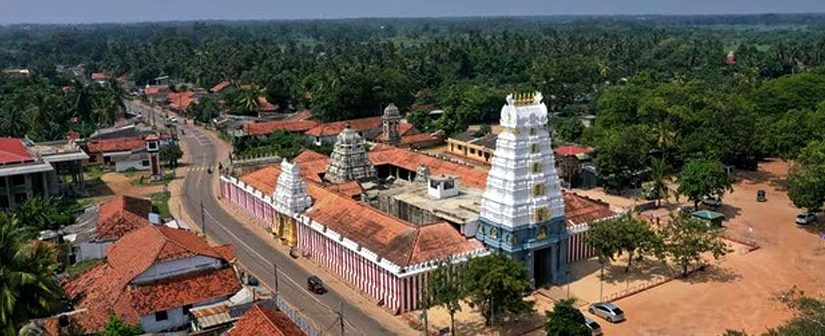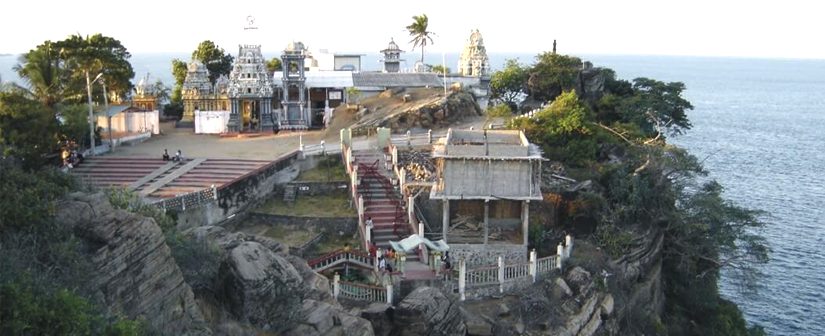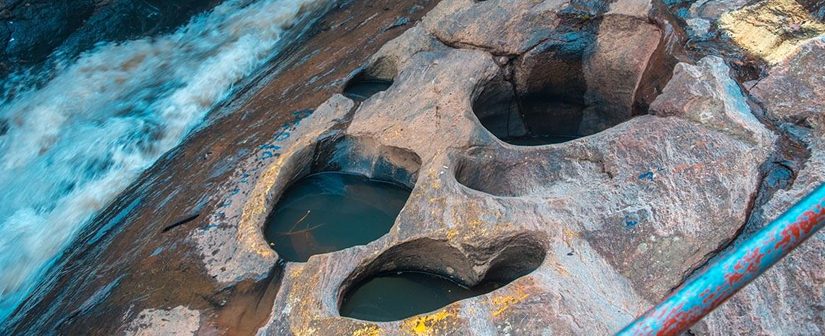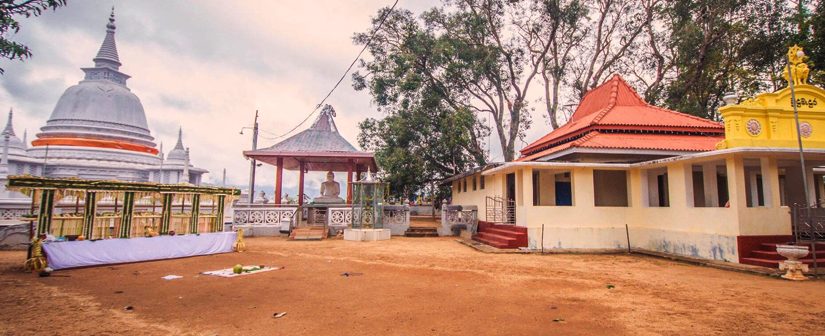Visitors from India who are familiar with the Hindu epic, Ramayana – the epic traditionally ascribed to the Rishi Valmiki which narrates the life of Rama, the legendary prince of the Kosala Kingdom – are in for a treat.
To attract more tourists from India, the Sri Lankan government has launched a Ramayana tourism Trail, which links all temples and caves in the country associated with the Hindu epic
Sri Lanka’s rich Ramayana heritage is the proud custodian of more than 50 Ramayana sites from the place of Seetha Devi’s captivity to the battlefields where vast armies clashed, to the groves of exotic herbs dropped by the monkey god Hanuman, to the ultimate theatre of war where Lord Rama slew Ravana, the ten-headed demon-king. Below are some important sites.
Ravana is revered as a great devotee of Hindu God Lord Shiva. There are many Temples of Lord Shiva where Ravana is also worshipped for his unfathomable devotion for Lord Shiva.
1. Chilaw
A town in the Puttalam District of Sri Lanka’s North Western Province. The destination is locally known for its 3 Cs- coconuts, crabs, and Coreas (Sri Lankafreedom fighters Charles Edgar Corea and Victor Corea who, with the help of Mahatma Gandhi, founded the Chilaw Association and the Ceylon National Congress).
Chillaw is known for its Manavari and Munneswaram temples that are a part of the Ramayana Trail in Sri Lanka.

Munneswaram Temple (![]() Get Directions): The legend mentions that after defeating King Ravana, Lord Rama left for Ayodhya in the Pushpak Viman but felt that he was being followed by Brahmahathi Dosham (the curse of killing a Brahmin). But he stopped here as he felt that the Dosham wouldn’t follow him here. He prayed to Lord Shiva who advised him to install and pray at four lingams in Manavari, Thiru Koneswaram, Thiruketheeswaram, and Rameshwaram to get rid of the Dosham.
Get Directions): The legend mentions that after defeating King Ravana, Lord Rama left for Ayodhya in the Pushpak Viman but felt that he was being followed by Brahmahathi Dosham (the curse of killing a Brahmin). But he stopped here as he felt that the Dosham wouldn’t follow him here. He prayed to Lord Shiva who advised him to install and pray at four lingams in Manavari, Thiru Koneswaram, Thiruketheeswaram, and Rameshwaram to get rid of the Dosham.
Manavari Temple or Ramalinga Shivan (![]() Get Directions): 9 km north of Chilaw is the only lingam in the world that is named after Lord Rama other than at Rameshwaram. According to the legend, it is here that Lord Rama first installed a Shiva lingam. Till date, this lingam is called as Ramalinga Shivan.
Get Directions): 9 km north of Chilaw is the only lingam in the world that is named after Lord Rama other than at Rameshwaram. According to the legend, it is here that Lord Rama first installed a Shiva lingam. Till date, this lingam is called as Ramalinga Shivan.
2. Trincomalee

The beachside town is known for its golden sandy beaches and Thiru Koneswaram Temple (![]() Get Directions) that sits idyllically at the edge of a cliff. The temple is said to have been built by Agastya Rishi on the instructions of Lord Shiva on being impressed by King Ravanas devotion. It is also said that Lord Rama built the second lingam here to get rid of the Brahmahathi Dosham.
Get Directions) that sits idyllically at the edge of a cliff. The temple is said to have been built by Agastya Rishi on the instructions of Lord Shiva on being impressed by King Ravanas devotion. It is also said that Lord Rama built the second lingam here to get rid of the Brahmahathi Dosham.
3. Nuwara Eliya
Nuwara Eliya, the City of Lights, is a resort town in the Central Mountain range of Sri Lanka. The city is known for its Gayathri Pedam, Seetha Amman Temple, & Divurumpola that are a part of the Ramayana tour in Sri Lanka. You’ll get a chance to revisit the past at these iconic temples that serve as milestones for the important incidents that occurred in the Ramayana.
Sri Baktha Hanuman Temple (![]() Get Directions): Ramboda is famous for its 109m-high Ramboda waterfalls, currently the longest road tunnel on A5 and the Sri Baktha Hanuman Temple. The temple was built by Chinmaya Mission on the hills where Lord Hanuman is believed to have begun the search mission for Goddess Sita.
Get Directions): Ramboda is famous for its 109m-high Ramboda waterfalls, currently the longest road tunnel on A5 and the Sri Baktha Hanuman Temple. The temple was built by Chinmaya Mission on the hills where Lord Hanuman is believed to have begun the search mission for Goddess Sita.
Gayathri Pedam (![]() Get Directions): Gayathri peedam is believed to be the place from where King Ravana’s son Meghanath propitiated Lord Shiva with penance and poojas and in turn was granted supernatural powers by Lord Shiva.
Get Directions): Gayathri peedam is believed to be the place from where King Ravana’s son Meghanath propitiated Lord Shiva with penance and poojas and in turn was granted supernatural powers by Lord Shiva.

Seetha Amman Temple (![]() Get Directions): This is the said to be the site of Ashok Vatika where Goddess Sita was held captive by King Ravana.
Get Directions): This is the said to be the site of Ashok Vatika where Goddess Sita was held captive by King Ravana.
4. Welimada

Divurumpola (![]() Get Directions): Located 15km from Seetha Eliya Nuwara Eliya – Welimada Road is the place where Seetha Devi underwent “Agni Pariksha” (A test). It’s a popular place of worship among locals. Divurumpola means place of oath in Sinhala. It is believed, that Goddess Sita was made to perform a fire test to prove her chastity and devotion to her husband Lord Rama after being freed from King Ravana’s captivity.
Get Directions): Located 15km from Seetha Eliya Nuwara Eliya – Welimada Road is the place where Seetha Devi underwent “Agni Pariksha” (A test). It’s a popular place of worship among locals. Divurumpola means place of oath in Sinhala. It is believed, that Goddess Sita was made to perform a fire test to prove her chastity and devotion to her husband Lord Rama after being freed from King Ravana’s captivity.
5. Colombo
The Anjaneyar temple in Colombo (![]() Get Directions) A temple run by a Hanuman devotee. Opens at 5:30 and closes at 20.00. The temple closes in the ternoon 13.00 – 16:30. A special pooja timing is 8:00 and 18.00-18:30.
Get Directions) A temple run by a Hanuman devotee. Opens at 5:30 and closes at 20.00. The temple closes in the ternoon 13.00 – 16:30. A special pooja timing is 8:00 and 18.00-18:30.
The Kelaniya Temple (![]() Get Directions), on the other hand, is believed to be the place where Vibheeshana was coronated as the king of Lanka after the death of his brother, King Ravana.
Get Directions), on the other hand, is believed to be the place where Vibheeshana was coronated as the king of Lanka after the death of his brother, King Ravana.
Other attractions of Ramayana Trail in Sri Lanka
- Ussangoda (
 Get Directions): Located on the Colombo – Kataragama road near Ambalantota it’s here that Lord Hanuman’s tail was set on fire by the Rakshasa’s, who in turn went on to torch some parts of King Ravana’s empire. Ussangoda is one of the torched areas, which is said to have been an airport used by King Ravana. It is one of the places that Lord Hanuman is believed to have set fire to with his tail.
Get Directions): Located on the Colombo – Kataragama road near Ambalantota it’s here that Lord Hanuman’s tail was set on fire by the Rakshasa’s, who in turn went on to torch some parts of King Ravana’s empire. Ussangoda is one of the torched areas, which is said to have been an airport used by King Ravana. It is one of the places that Lord Hanuman is believed to have set fire to with his tail. - Rumassala in Galle (
 Get Directions): It is a part of the hill that Lord Hanuman carried from the Himalayas to Sri Lanka. It is believed that he dropped the mountain en route that resulted in numerous pieces of the Sanjeevni mountain in Sri Lanka.
Get Directions): It is a part of the hill that Lord Hanuman carried from the Himalayas to Sri Lanka. It is believed that he dropped the mountain en route that resulted in numerous pieces of the Sanjeevni mountain in Sri Lanka. - Ritigala caves (
 Get Directions): These are a set of 70 caves at one of the drop sites of the Sanjeevni mountain in Sri Lanka.
Get Directions): These are a set of 70 caves at one of the drop sites of the Sanjeevni mountain in Sri Lanka. - Seenigama Temple in Hikkaduwa (
 Get Directions): The land on which the Seenigama Temple is located on a small island can be accessed only by boat. It is believed to be the place where Sugreeva started his battle against the troops of Ravana.
Get Directions): The land on which the Seenigama Temple is located on a small island can be accessed only by boat. It is believed to be the place where Sugreeva started his battle against the troops of Ravana. - Cobra Hooded Cave in Sigiriya (
 Get Directions): It is believed to be one of the places associated with the captivity of Goddess Sita.
Get Directions): It is believed to be one of the places associated with the captivity of Goddess Sita.
Read: Visiting Places of Worship
Sri Lanka Holiday Guru Tip
As you’re entering a place of worship it’s best to cover shoulders and legs, no short dresses allowed.




